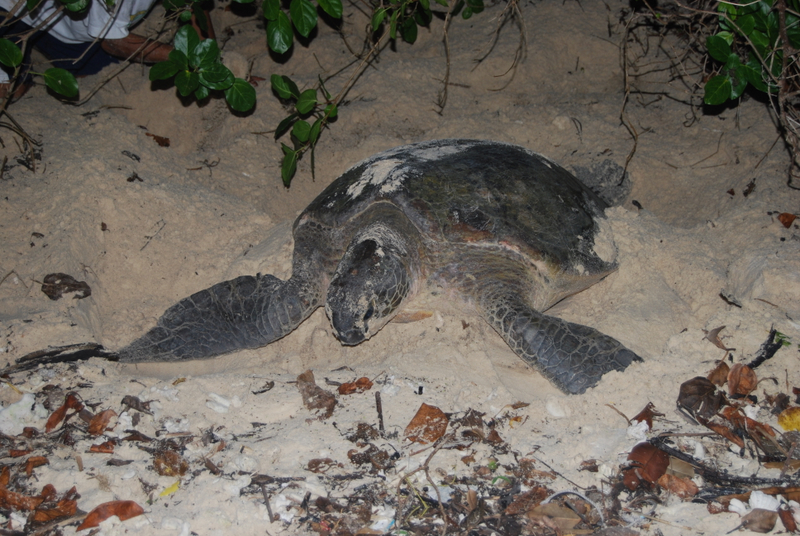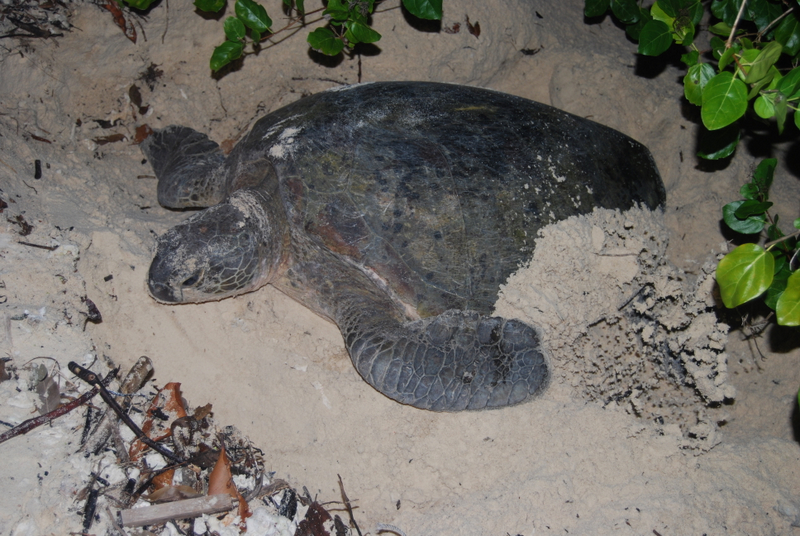 Yes, it’s not the tyre track of a large mechanical monster, but the pathway of a single Green Turtle, going back to the sea after nesting on Sipadan Island.
Yes, it’s not the tyre track of a large mechanical monster, but the pathway of a single Green Turtle, going back to the sea after nesting on Sipadan Island.
The eggs are collected – mostly to keep them safe from the huge monitor lizards, and the young released at night when they hatch. Human interference is not a problem here, due to the military presence on the island.

This particular turtle laid under some bushes, well up the beach. You can see her shifting sand with her flippers. She must have been more than a metre in length.
Note how deep she laid the eggs, being collected here by the wildlife officer. His right arm is buried up to the shoulder as he extracts them. The eggs are soft-shelled but tough and therefore not easily broken…

And here’s a tongue-in-cheek etymological lesson for Americans: turtles have flippers and spent most of their life in water. The other guys – the ones with legs and feet and claws are called tortoises, and live mostly on land…

So cool. Do the guys release the baby turtles at the water’s edge, or do they still have to make the long crawl down the beach by themselves?
They used to take them out in a boat, but I believe this is now thought not to such a good idea, as the hatchlngs need time to orient themselves. Now they are released on the sand, close to the water’s edge. Actually I didn’t see this, as the nights we were there the only hatchings decided to come out at 3 in the morning, long after I was asleep.
The wildlife people stay awake all night to track the arrivals and the hatching, and they released them.
Question: I have been told that mature turtles always return to their own hatching place to lay their eggs.
If their hatching site is no longer available for access (development, erosion, barriers etc) do they find a new place or abandon the cycle?
Peter, if you look back at the previous pix of Sipadan, you will see my husband taking some shots from the beach. He was actually photographing (not very successfully) the mating of the turtles – in other words, the males and females have to get together right close to the nesting site. The eggs are ready and waiting, he does what he has to, and she comes in to do the laying soon afterwards, certainly within a day or two.
So if she can’t find the place where she was born, and neither can he, one wonders if they also have a problem getting together in the first place…
I imagine she would look for places nearby. I have heard of turtles coming ashore, but not laying. So maybe there is always the possibility the female can check out the beach before selecting a spot. And they can also take a look by raising their head above the water.
However, I’m no expert on turtles!!
On the Florida beaches, where there is so much development, the turtles and their eggs are very much endangered by humans and it has become a big problem which is one of the reason they retrieve the eggs to hatch – I am surprised they have to do the same in Malaysia.
People eat the eggs here, Jo…
On this particular island though, the problem is the huge monitor lizards, one of which could easily eat a whole nest of eggs in one night.
I didn’t realise people ate the turtle eggs – no reason why not I suppose, people eat the turtles after all. At least the Monitor Lizards are a natural hazard. Although demolishing a whole nest in one fell swoop is a great pity.